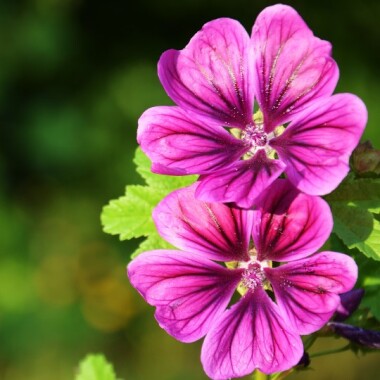
Tips for organic cultivation of Malva
(Malva sylvertris)

The Malva has extraordinary beauty and countless medicinal properties; The part that is used is its leaves and flowers, which of course are used in most areas. In Iran, its dried purple flowers are used. Malva has antimicrobial, pain-relieving, liver-protecting, wound healing, anti-cancer, anti-inflammatory and strong antioxidant properties. Also, this plant contains many valuable compounds such as antioxidants and strong carbohydrates and unsaturated fatty acids.
Malva, among popular medicinal plants, is a creeping plant, annual, biennial, or rarely multi-year herb; And by car, you go to many places; The height of this plant is different and depends on the climatic conditions of the place where it grows (between 50 and 100 cm). The lower part of the stem (foot of the stem) is more or less wooden; The root of Mlava is more or less branched, conical, straight and its thickness is 1.5 to 2.5 cm.
The seeds of Malva are bean-shaped and brown in color; The leaves are located alternately on the stem; The petioles and petals of this hairy plant and the flowers are pink; The sepals are streaked and purple in color; The cheese fruit is also flat and has ten parts.
Malva planting method
Direct sowing of seeds
If you intend to grow Malva flowers, you must first prepare high-quality Paneerak seeds.
Soak the seeds in lukewarm water for 24 hours.
Before planting the seeds, raise and lower the ground with a rake and remove any weeds, plant roots, stones, lumps, etc. from the soil; Then add rotted manure to it and turn the bed soil to a depth of 20 cm.
After performing this operation, smooth the surface of the soil well; Before sprinkling the seeds, water the surface of the soil well and then sprinkle the seeds on the soil. It is better to pour about half a centimeter of fully decomposed manure on it and water again with a sprinkler.
Place the seeds 1 cm deep in the soil.
7 to 21 days after planting the seeds, you will see their germination.
The flowering time of this plant is summer.
To collect the flowers of the Malva, it is better to do it when they open, which is mostly in the summer. Collection of leaves should also be done in spring. In fact, the best time to harvest the leaves is when the plants are in flower.At this stage, the leaves contain the most effective substances.After drying the plants, they are stored in non-plastic containers away from light and moisture.
Time: The best time to plant Malva flowers in the main bed is in spring in cold regions or early autumn (in tropical regions). The ideal time to plant fennel seeds outdoors depends on your climate. In most cases, you should wait until the risk of frost has passed in the spring. In areas with mild winters, you can sow seeds in autumn.
Location: Choose a location that receives full sun to partial shade. Malva prefers well-drained soil, so avoid areas that tend to stay wet.
Spacing: When the bushes appear, you need to separate them so that they grow properly. Consider a distance of 50 cm between mature plants.
Watering: Keep the soil moist until the plants are established in the soil. After that, cheese is relatively drought resistant.
To improve drainage and supply nutrients to plants, you can enrich the soil with compost before planting.
Types of Malva
There are about 25 species of Malva plant, most of which are native to Europe and Asia. Some of the popular types of Malva are shown in the following pictures:
Care and maintenance of Malva
Sunlight and soil
It prefers full sun to partial shade. For optimal flowering, consider at least 6 hours of direct sunlight per day. The Malva plant needs a lot of water during its growth, and deep plowing of the soil in autumn prepares the soil well for planting Malva. Malva is adaptable to most soil conditions, but thrives in well-drained soil. If your soil is heavy clay, amend it with some sand or compost to improve drainage. Malva flower is one of the plants that do not have much soil expectations and can be cultivated and grown in most soils, but it prefers rich soils with proper drainage. The soil in which this plant is grown must be very thick. Since this plant is sensitive to most herbicides, it should be planted alternately with plants that prevent the spread of weeds, therefore, weed plants are suitable plants for alternating planting with malva; The combination of cocopeat, peat moss and leaf soil in equal proportions provides a suitable substrate for planting malva.
Irrigation
After growing and strengthening in the soil, malva is relatively resistant to drought. Water regularly for the first few weeks after planting to help the roots grow. After that, only water deeply when the soil feels dry to the touch. Avoid overwatering, as this can lead to root rot.
Fertilizer
Malva is not a heavy feeder and generally does not require additional fertilizer, especially if your soil is fertile. However, if your plants are looking weak or showing poor growth, you can give them a light feeding of a balanced organic fertilizer once during the growing season.
Pruning
Remove wilted flowers during the blooming season to help the plant keep blooming. You can pinch them off with your fingers. Pruning is not necessary, but light pruning in mid-summer can help the plant grow bushier and produce more flowers.
Pests and diseases
Malva is generally resistant to pests and diseases. However, it can sometimes be affected by aphids, slugs, or powdery mildew. If these issues arise, they should be controlled using non-chemical and organic methods.
سبد خرید






